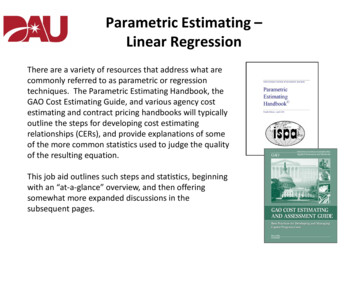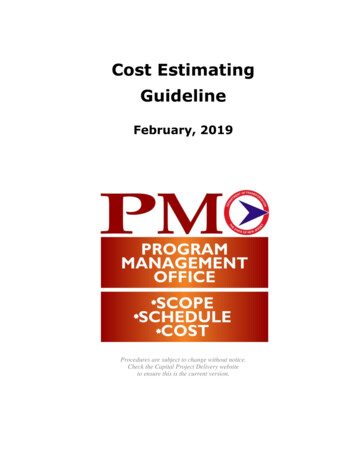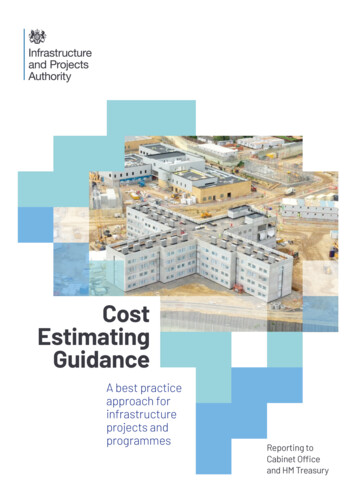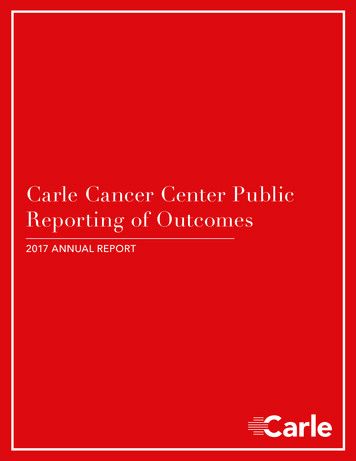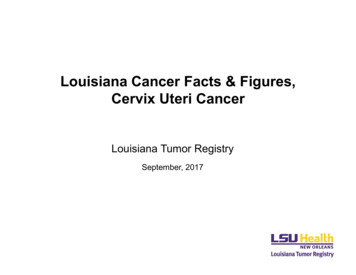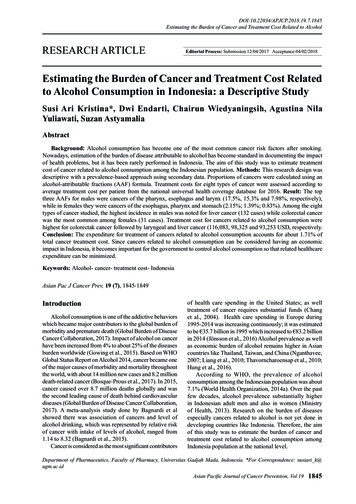
Transcription
DOI:10.22034/APJCP.2018.19.7.1845Estimating the Burden of Cancer and Treatment Cost Related to AlcoholRESEARCH ARTICLEEditorial Process: Submission:12/04/2017 Acceptance:04/02/2018Estimating the Burden of Cancer and Treatment Cost Relatedto Alcohol Consumption in Indonesia: a Descriptive StudySusi Ari Kristina*, Dwi Endarti, Chairun Wiedyaningsih, Agustina NilaYuliawati, Suzan AstyamaliaAbstractBackground: Alcohol consumption has become one of the most common cancer risk factors after smoking.Nowadays, estimation of the burden of disease attributable to alcohol has become standard in documenting the impactof health problems, but it has been rarely performed in Indonesia. The aim of this study was to estimate treatmentcost of cancer related to alcohol consumption among the Indonesian population. Methods: This research design wasdescriptive with a prevalence-based approach using secondary data. Proportions of cancers were calculated using analcohol-attributable fractions (AAF) formula. Treatment costs for eight types of cancer were assessed according toaverage treatment cost per patient from the national universal health coverage database for 2016. Result: The topthree AAFs for males were cancers of the pharynx, esophagus and larynx (17.5%, 15.3% and 7.98%, respectively),while in females they were cancers of the esophagus, pharynx and stomach (2.15%; 1.39%; 0.83%). Among the eighttypes of cancer studied, the highest incidence in males was noted for liver cancer (132 cases) while colorectal cancerwas the most common among females (31 cases). Treatment cost for cancers related to alcohol consumption werehighest for colorectak cancer followed by laryngeal and liver cancer (116,083, 98,325 and 93,253 USD, respectively.Conclusion: The expenditure for treatment of cancers related to alcohol consumption accounts for about 1.71% oftotal cancer treatment cost. Since cancers related to alcohol consumption can be considered having an economicimpact in Indonesia, it becomes important for the government to control alcohol consumption so that related healthcareexpenditure can be minimized.Keywords: Alcohol- cancer- treatment cost- IndonesiaAsian Pac J Cancer Prev, 19 (7), 1845-1849IntroductionAlcohol consumption is one of the addictive behaviorswhich became major contributors to the global burden ofmorbidity and premature death (Global Burden of DiseaseCancer Collaboration, 2017). Impact of alcohol on cancerhave been increased from 4% to about 25% of the diseasesburden worldwide (Gowing et al., 2015). Based on WHOGlobal Status Report on Alcohol 2014, cancer became oneof the major causes of morbidity and mortality throughoutthe world, with about 14 million new cases and 8.2 milliondeath-related cancer (Bosque-Prous et al., 2017). In 2015,cancer caused over 8.7 million deaths globally and wasthe second leading cause of death behind cardiovasculardiseases (Global Burden of Disease Cancer Collaboration,2017). A meta-analysis study done by Bagnardi et alshowed there was association of cancers and level ofalcohol drinking, which was represented by relative riskof cancer with intake of levels of alcohol, ranged from1.14 to 8.32 (Bagnardi et al., 2015).Cancer is considered as the most significant contributorsof health care spending in the United States; as welltreatment of cancer requires substantial funds (Changet al., 2004). Health care spending in Europe during1995-2014 was increasing continuously; it was estimatedto be 35.7 billion in 1995 which increased to 83.2 billionin 2014 (Jönsson et al., 2016) Alcohol prevalence as wellas economic burden of alcohol remains higher in Asiancountries like Thailand, Taiwan, and China (Nganthavee,2007; Liang et al., 2010; Thavorncharoensap et al., 2010;Hung et al., 2016).According to WHO, the prevalence of alcoholconsumption among the Indonesian population was about7.1% (World Health Organization, 2014a). Over the pastfew decades, alcohol prevalence substantially higherin Indonesian adult men and also in women (Ministryof Health, 2013). Research on the burden of diseasesespecially cancers related to alcohol is not yet done indeveloping countries like Indonesia. Therefore, the aimof this study was to estimate the burden of cancer andtreatment cost related to alcohol consumption amongIndonesia population at the national level.Department of Pharmaceutics, Faculty of Pharmacy, Universitas Gadjah Mada, Indonesia. *For Correspondence: susiari k@ugm.ac.idAsian Pacific Journal of Cancer Prevention, Vol 191845
Susi Ari Kristina et alMaterials and MethodsThis research was secondary data study by usingestimation prevalence-based with detail of diseases(Pérez-Ríos and Montes, 2008). Calculation of treatmentcost based on concept of cost of illness by usinggovernmental perspective. Direct estimates of morbiditycannot be made because there is a lack of longitudinalstudies on the differential morbidity of alcohol drinkers,light, moderate, and heavy drinker, necessary to provideRR estimates for alcohol-related diseases. Original methodproposed by Peto et al., (1992) requires incidence ratesin those who did not expose risk factor, which are notavailable in Indonesia.The alcohol consumption prevalenceThe prevalence of drinkers in Indonesia was obtainedfrom the WHO Global Status Report on Alcohol andHealth 2014. The report contained data on the prevalenceof alcohol use, heavy drinker status among the Indonesiapopulation for 15 years of age was 4.9% among maleand 0.3% among the female (World Health Organization,2014a).Relative riskRelative risk (RR) was calculated as per meta-analysisstudy associated with alcohol use and risk of cancer(Bagnardi et al., 2015). In our study RR was calculatedfor heavy intake of alcohol consumption adjusted withthe available prevalence of data on alcohol consumption.Determination of cancer related to alcohol consumptionThe study included risks of 8 types of cancer likecancer of oral cavity, pharynx, esophagus, stomach,colorectum, liver, pancreas, larynx and lung with alcoholconsumption. The data obtained was adjusted to the dataavailable with BPJS 2016 (Indonesian Universal HealthCoverage (BPJS), 2016) and RR from the meta-analysisstudy and alcohol-attributable fraction was calculated.Incidence number of cancersIncidence number of eight types of cancers wasretrieved through secondary data from BPJS 2016(Indonesian Universal Health Coverage (BPJS), 2016).Estimation alcohol-attributable fractions (AAFs) andmorbidityAAFs represent the proportion of morbidity due toalcohol with the following formula:AAFwhere:i exposure category with the initial exposure or noexposure (i 0);RRi the relative risk exposure at the level i comparedwith no consumption;Pi the prevalence or incidence of exposure category(Rehm et al., 2009).Then, incidence number or morbidity of cancer relatedto alcohol consumption (AAI) can be calculated by theformula:Where:AAF alcohol-attributable fraction of cancers;I morbidity (incidence number) of type of cancers.Calculation treatment cost of cancer related to alcoholconsumptionThe direct costs of all cancers treatment for this studywas obtained from the data of the National BPJS 2016.Treatment cost of cancers related to alcohol consumptionwas calculated by multiplying AAI with the treatment costof cancer per patient.Sensitivity analysisOne-way sensitivity analysis has done in an effort toidentify the variables that potentially lead to significantchanges in the results of the study. Variation of prevalenceof alcohol consumption and relatives risk had assessedusing one-way sensitivity analysis.ResultsIn the study, highest AAFs among males were seenfor cancer of pharynx (17.50%) followed by cancer ofesophagus and larynx and among females it was seenfor cancer of esophagus (2.15%) followed by cancer ofpharynx and stomach (Table 1).Table 1. The Proportion of Eight Types of Cancer Related to Alcohol Consumption on Alcohol-Attributable Fractions(AAFs)No.CancerICD-10RR*AAFs (%)codeMaleFemaleMaleFemale1ColorectumC 18-211.533.232.530.662EsophagealC 154.698.3215.312.153LarynxC 322.771.557.980.164LiverC 221.591.242.810.075PharynxC 00-145.335.717.51.396PancreasC 251.161.170.780.057LungC 33-341.141.20.680.068StomachC 161.23.80.970.83*RRs were obtained from Bagnardi (Bagnardi V et al., 2015)1846Asian Pacific Journal of Cancer Prevention, Vol 19
DOI:10.22034/APJCP.2018.19.7.1845Estimating the Burden of Cancer and Treatment Cost Related to AlcoholTable 2. Number of Mortality (NOM) and Alcohol-Attributable Morbidity (AAM) of Eight Types of Cancer Relatedto Alcohol Consumption in Indonesia 1ColorectumC 18-215,2044,636132311632EsophagusC 15288145443473LarynxC 321,30531410411054LiverC 227,6493,35821522175PharynxC 00-1414493251266PancreasC 251,0138998N/A87LungC 33-347,8794,220543568StomachC 5%% of eight types of cancerNOM, Number of mortality; AAM, Alcohol-attributable mortality; N/A, not availableTable 3. Total Treatment Cost of Eight Types of Cancer Related to Alcohol Consumption in Indonesia 2016CancerICD-10 codeMaleFemaleTotal of treatment cost (USD)AAMTreatment cost (USD)AAMTreatment cost (USD)ColorectumC 18-2113295,170.893120,912.48116,083.37EsophagealC 154442,326.2631,494.3443,820.60LarynxC 3210498,107.121217.8198,324.93LiverC 2221592,305.232948.0693,253.29PharynxC 00-142510,830.101203.5911,033.69PancreasC 2585,613.22N/AN/A5,613.22C 33-345442,997.7631,839.0844,836.84C 15416,227.34LungStomachTotalN/A, not available; 1 USD, IDR 13,369 (based on i-bi/Default.aspx per December 31st, 2016);In the study, highest AAM among males were seenfor liver cancer (215 cases) followed by colorectal cancerand cancer of larynx (132 and 104 cases) respectivelyand among females it was seen for cancer of colorectum(31cases) followed by cancer of stomach, lung andesophagus (5, 3, and 3) respectively (Table 2).Among the treatment cost, the total cost ofcancer-related to alcohol consumption was highestamong males (3, 88,952.19 USD) as compared to females(27,275.15 USD). Treatment costs among the 8 types ofcancer-related to alcohol consumption among males werecancer of larynx which topped the list with 98.107.12USD followed by colorectal and liver cancer (95,170.89and 92,305.23 USD) respectively and among the femaleswere colorectal cancer (20,912.48 USD ) topped the list, followed by lung and esophageal cancer (1,839.08 and1,494.34 USD) respectively. Overall, the highest totaltreatment cost of cancer-related to alcohol consumptionespecially in heavy level intake of alcohol was seen forcolorectal cancer (116,083.37 USD) followed by cancerof larynx and liver (98,324.93 and 93,253.29 USD)respectively.One-way sensitivity used by changing prevalenceof alcohol consumption and relative risk of eight typesof cancer related to alcohol consumption. Table 4 showprevalence changes by decreasing prevalence about 1%,3% and 5% then, also increasing prevalence about 5%,10%, and 20%.Table 4. Data Changes Due to Prevalance AlternativePrevalenceAAF (%)AAM (%)Total treatment cost (%)MaleFemaleMaleFemaleMaleFemaleDeccreased 1%-0.9-1-1-1-0.9-1Decreased 3%-2.6-3-2.9-3-2.8-3Decreased 5%-4.4-4.9-4.8-5-4.7-5Increased 5%4.34.94.754.75Increased 10%8.69.89.59.99.49.9Increased 20%1719.718.819.818.719.8Asian Pacific Journal of Cancer Prevention, Vol 191847
Susi Ari Kristina et alDiscussionOur study was the first study done in Indonesiato estimate the treatment cost of cancers related toalcohol consumption. Our study described the burden ofcancer-related to alcohol consumption and would becomea baseline study for the government to have controlmeasures related to alcohol consumption so as to reducethe harmful effects of alcohol consumption. Alcohol wasresponsible for 1.65% of all cancer cases and treatmentcost of cancer-related to alcohol consumption was seenhighest in colorectum cancer followed by larynx and livercancer in USD (116,083, 98,325 and 93,253) respectively.Prevalence of cancers both in male and female hassimilarity on three top cancer, there were cancer of lung,liver, and colorectum. When compared to Globocan data2012, estimated prevalence number of cancers on three topplaces in Indonesia also occupied by cancer of lung in firstplace (16.3% of total incidence of cancer in Indonesia)then followed by cancer of colorectum (12.8%), and liver(8.4%) (World Health Organization, 2014b).Eight types of cancer in Indonesia both in male andfemale majority occurred in elderly population. Based onWHO data, life expectancy of the Indonesia populationthat is surviving at older ages in 2015 was about 67years for male and 71 years for female. Age significantlyincreases the risk of cancer. In elderly people, otherlifestyle that associated risks will also accumulated. Therisk factors for the most common cancers have a longtime to impact and increase the risk of disease in olderpeople. A study explained that the incidence of mostcancers increases with age, rising more rapidly beginningin midlife (45-64 years) (Whiteman and Wilson, 2016).Based on previous research, mechanism of the increase incancer risk with age was related to dose-duration effect ofcarcinogenic exposures (Scoccianti et al., 2015).AAFs was aimed to estimate the proportion ofeach cancer cases related to alcohol consumption. Thehighest AAFs in male is 17.50% can be interpretedthat the proportion of pharynx cancer related to alcoholconsumption is about 17.50% then followed by esophagealcancer (15.18%) and larynx cancer (7.91%). Then, forfemale, the highest AAFs is 2.15% can be interpreted thatthe proportion of esophageal cancer related to alcoholconsumption is about 2.15%, then followed by pharynxcancer (1.39%) and stomach cancer (0.83%). From here,it can be showed that AAFs value in female smaller thanmale because the prevalence of heavy drinker in femaleis less than male.Morbidity of eight types of cancer related to alcoholin male was higher than female, it was about 586 cases inmale (2.45% of total incidence of eight types of cancer)and 47 cases (0.33% of total incidence of eight typesof cancer). This was in accordance with prevalence ofalcohol consumption higher in male than female. Overall,liver cancer have highest AAM that showed numberof case of liver cancer due to alcohol consumption, itwas about 217 cases (1.98% of total incidence of livercancer), then followed by colorectum cancer (163cases), and larynx cancer (105 cases). These trend wasalso happened in China, a study by Liang et al., (2010),1848Asian Pacific Journal of Cancer Prevention, Vol 19showed that liver cancer was the main alcohol-relatedcancer, contributing more than 60% of alcohol-relatedcancer with total incidence number of liver cancer dueto alcohol consumption. Among Korean women, theAAF for colorectal cancer incidence was the highest(4.2%) and about 0.5% (464 cancer cases) of incidentcancers were attributable to alcohol consumption (Parket al., 2014). Based on research by Chang et al. (2017)examined about the association between alcohol andcancer in Asian people has been stating that ALDH2polymorphism (ALDH2*2 allele) was responsible andplay a role in causing cancer related to alcohol (Changet al., 2017). López-Lázaro (2016) also explained therewas a local mechanism of alcohol causing cancer. Ethanolthat presenting in alcoholic beverages can causes a localcytotoxic effect in cells lining until cell death happenedwhen the ethanol was passing the epithelial tissues suchas in oral cavity, pharynx and esophagus.Treatment cost of eight types of cancer related toalcohol consumption analyzed by calculating the directtreatment cost of eight types of cancer in Indonesia2016. Total treatment cost of cancer related to alcoholconsumption in 2016 was about 416,227.34 USD or 1.71%of total treatment of eight types of cancer. It was about0.008% of total healthcare expenditure by governmentin 2016. Our finding was similar with previous researchconducted in Thailand. The direct cost on health carewas about 5,491.2 million Bath including treatment costfor laryngeal cancer, liver cancer, mouth and oropharynxcancer, esophageal cancer, stomach cancer and otherdiseases (Thavorncharoensap et al., 2010). Chemotherapyand radiation therapy use were the common largest costof cancer treatment (Warren et al., 2008).According to Basic Health Survey report 2013, canceras a non-communicable diseases (NCDs) has prevalencedata less than among other NCDs such as asthma andchronic obstructive pulmonary disease (COPD) (Ministryof Health, 2013). Even cancer prevalence less than others,but cancer classified as catastrophic diseases which hasthe characteristics of high cost and high risk of death,then actually much cost spent on cancer treatment. Likedeveloping countries, developed countries also explainedcancer is among the most significant contributors ofhealthcare spending, with direct treatment cost in 2002at 60.9 billion USD (Chang et al., 2004), in 2006 spenthealthcare cost about 11% (Bouchery et al., 2011) then in2014 has increased to 87.7 billion USD (American CancerSociety, 2017). Interventions such as increased excisetaxes, educational approaches highlighted the dangersof alcohol use are the most cost-effective interventionto reduce alcohol use (Kelly-Weeder et al., 2011). Thenpolicy initiatives such as imposing punishment andprohibition for inebriation to reduce prevalence of alcoholconsumption (Lai et al., 2007).However, some limitations of the study need to bediscussed. This result could be said to be under estimationwith real cost because of some factors including thenumber of participants covered by national insurer wasabout 70% of total Indonesia population. In addition, notall participants utilize the health services offered by BPJS,for example some cancer patients prefer to use alternative
DOI:10.22034/APJCP.2018.19.7.1845Estimating the Burden of Cancer and Treatment Cost Related to Alcoholtreatment such as traditional medicine rather than formalhealth care services. Another limitation is relative risk(RR) has been used in this research was not from Indonesiathen it could not represented fully of Indonesia’s cancercondition which is affected by demographic differences,and comorbidity disease beside cancer affected by otherlifestyles. Our finding could be considered by governmentto reduce healthcare expenditure of cancer related toalcohol wherefore the prevalence of alcohol consumptionhas increased in recent years.Despite these limitations, our results show theimportance and the priority to be accorded to reducethe rate of alcohol consumption in the Indonesianpopulation. A reduction in alcohol consumption woulddecrease the cancer burden and a significant impact isanticipated specifically for healthcare cost related toalcohol consumption.ReferencesBagnardi V, Rota M, Botteri E, et al (2015). Alcohol consumptionand site-specific cancer risk: a comprehensive dose-responsemeta-analysis. Br J Cancer, 112, 580-93.Bouchery EE, Harwood HJ, Sacks JJ, et al (2011). Economiccosts of excessive alcohol consumption in the U.S. Am JPrev Med, 41, 516-24.Chang JS, Hsiao JR, Chen CH (2017). ALDH2 polymorphismand alcohol-related cancers in Asians: a public healthperspective. J Biomed Sci, 24, 3524-30.Chang SR, Long S, Kutikova L (2004). Estimating the costof cancer: Results on the basis of claims data analyses forcancer patients diagnosed with seven types of cancer during1999 to 2000. J Clin Oncol, 22, 3524-30.Global Burden of Disease Cancer Collaboration (2017). Global,regional, and national cancer incidence, mortality, years oflife lost, years lived with disability, and disability-adjustedfife-years for 32 cancer groups, 1990 to 2015: A systematicanalysis for the Global Burden of Disease Study. JAMAOncol, 3, 524-48.Gowing LR, Ali RL, Allsop S, et al (2015). Global statistics onaddictive behaviours: 2014 status report: Addiction globalstatistics. Addiction, 110, 904-19.Hung MC, Lai WW, Chen HHW, et al (2016). Cost effectivenessof cancer treatment in Taiwan. J Formos Med Assoc, 115,509-16.Jönsson B, Hofmarcher T, Lindgren P, et al (2016). The cost andburden of cancer in the European Union 1995-2014. Eur JCancer, 66, 162-70.Kelly-Weeder S, Phillips K, Rounseville S (2011). Effectiveness ofpublic health programs for decreasing alcohol consumption.Patient Intell, 29, 29-38.Lai T, Habicht J, Reinap M, et al (2007). Costs, health effects andcost-effectiveness of alcohol and tobacco control strategiesin Estonia. Health Policy, 84, 75-88.Liang H, Wang J, Xiao H, et al (2010). Estimation of cancerincidence and mortality attributable to alcohol drinking inChina. BMC Public Health, 10, 730-5.López-Lázaro M (2016). A local mechanism by which alcoholconsumption causes cancer. Oral Oncol, 62, 149-52.Nganthavee W (2007). The economic burden of smoking-relateddisease in Thailand: a prevalence-based analysis. J MedAssoc Thai, 90, 1925-9.Park SM, Lu Z, Lee C (2014). Attributable fraction of alcoholconsumption on cancer using population-based nationwidecancer incidence and mortality data in the Republic of Korea.BMC Cancer, 14, 14420.Pérez-Ríos M, Montes A (2008). Methodologies used to estimatetobacco-attributable mortality: a review. BMC Public Health,8, 8-22.Peto R, Lopez AD, Boreham J, et al (1992). Mortality fromtobacco in developed countries: indirect estimation fromnational vital statistics. Lancet, 339, 1268-78.Rehm J, Mathers C, Popova S, et al (2009). Global burden ofdisease and injury and economic cost attributable to alcoholuse and alcohol-use disorders. Lancet, 373, 2223-33.Scoccianti C, Cecchini M, Anderson AS, et al (2015). Europeancode against cancer 4th Edition: Alcohol drinking and cancer.Cancer Epidemiol, 39, 67-74.Thavorncharoensap M, Teerawattananon Y, Yothasamut J, etal (2010). The economic costs of alcohol consumption inThailand. BMC Public Health, 10, 323-7.Warren Jl, Yabroff KR, Meekins A, et al (2008). Evaluation oftrends in the cost of initial cancer treatment. J Natl CancerInst, 100, 888-97.Whiteman DC, Wilson LF (2016). The fractions of cancerattributable to modifiable factors: A global review. CancerEpidemiol, 44, 203-21.This work is licensed under a Creative Commons AttributionNon Commercial 4.0 International License.Asian Pacific Journal of Cancer Prevention, Vol 191849
three AAFs for males were cancers of the pharynx, esophagus and larynx (17.5%, 15.3% and 7.98%, respectively), while in females they were cancers of the esophagus, pharynx and stomach (2.15%; 1.39%; 0.83%). Among the eight types of cancer studied, the highest incidence in males was noted for liver cancer (132 cases) while colorectal cancer



